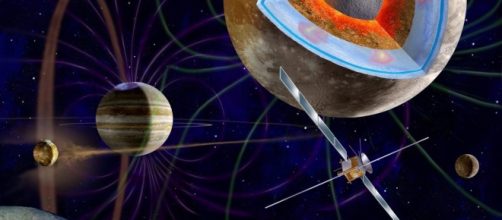Jupiter Icy moons Explorer (JUICE) is the first space class mission that will study Jupiter and its moons. The mission was selected as a first large class mission within ESA cosmic scheme. The mission will spend three and one half years observing the Jupiter´s system. It´s planned to be launched in 2022 and after a seven years journey will arrive at Jupiter in 2030.
The mission
The spacecraft will spend three and a half years orbiting Jupiter, exploring its magnetosphere, atmosphere and dark rings. It will also study three of Jupiter´s moons; Europa, Ganymede and Callisto; these three planet sized moons are believed to have bodies of water underneath their crusts of ice, which can provide evidence of microbial life forms.
On its last year, this mission will be inserted into an orbit around Ganymede, exploring and recording its structure.
Instruments
Juice instrument payload includes 10 high-technology science instruments, including spectrometers, high resolution cameras, ice mapping radar, radio-science testing devices, an altimeter, a magnetometer instrument for mapping Jupiter´s magnetic field, sensors for recording charged particles and a reliable instrument for combining feedback communication between the spacecraft and earth. Based instruments.
Exploration of Jupiter
During the 1970s various spacecraft have visited the planet Jupiter. Pioneer missions were able to get a close up of Jupiter´s atmosphere and the Galilean moons.
The spacecraft revealed that the radiation field was stronger than thought, nearly 14 times stronger than the one on earth. Over time, voyager missions expanded the understanding of the Galilean moons and discovered Jupiter’s rings. They also confirmed that the Great Red Spot was a high atmospheric pressure.
Why study Jupiter?
Jupiter is the model of other gas giant planets farther in the solar system and other gas giant exoplanets known to orbit a star in the far away cosmos. Three of the Galilean moons are thought to harbor microscopic life within them. Understanding the Jovian system as a whole can broaden the understanding of its origins and provide clues of how Jupiter like planets could have evolved in other planetary systems. This will expand scientists understanding for future studies in cosmology.

